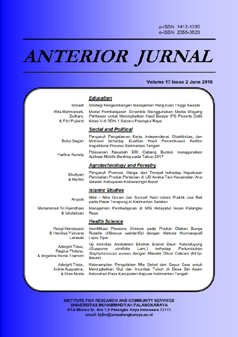Strategi BNNK Sleman dalam Mengurangi Penyalahgunaan dan Peredaran Gelap Narkoba: Perspektif Collaborative Governance BNNK Sleman's Strategy in Reducing Drug Abuse and Illicit Trafficking: Collaborative Governance Perspective
Main Article Content
Abstract
Drug abuse and illicit trafficking remain pressing issues for Indonesia through 2024. This is evident from the increase in drug abuse prevalence in Indonesia by 1.73%, according to a National survey conducted in 2023. The widespread negative impacts make addressing this issue increasingly complex and multidimensional. Sleman has become one of the districts in Yogyakarta that receives special attention in this matter topic. Factors such as student migration, urbanization, and tourism development are the main drivers of the high risk of drug abuse in this area. BNNK Sleman is responsible for designing and implementing effective strategies to reduce and prevent drug abuse and illicit trafficking in the Sleman District. The primary goal of this study is to identify and analyze BNNK Sleman's strategies through the lens of Collaborative Governance. The research method used in this study is a descriptive qualitative approach, with purposive sampling selected as the sampling method. Data were collected through three main methods: direct observation, in-depth interviews, and documentation. The comparison of observational and interview data reveals that the principles of inclusiveness, transparency, accountability, cross-sector collaboration, face-to-face dialogue, and trust-building have been integrated into effective strategies with varying degrees of success. Active community participation, the use of digital technology, and strong accountability are key elements of this strategy. This study highlights the importance of enhancing transparency and accountability through technology to improve public participation and the sustainability of cross-sector collaboration, while also providing significant insights into the implementation of Collaborative Governance at the local level.
Downloads
Article Details

This work is licensed under a Creative Commons Attribution-ShareAlike 4.0 International License.
All rights reserved. This publication may be reproduced, stored in a retrieval system, or transmitted in any form or by any means, electronic, mechanical, photocopying, recording.
References
Ahern, J. 2011. From Fail-Safe to Safe-to-Fail: Sustainability and Resilience in the New Urban World. Landscape and Urban Planning, 100(4): 341–343. https://doi.org/10.1016/j.landurbplan.2011.02.021
Ansell, C., & Gash, A. 2008. Collaborative Governance in Theory and Practice. Journal of Public Administration Research and Theory, 18(4): 543–571. https://doi.org/10.1093/jopart/mum032
Astuti, R. S., Warsono, H., & Rachim, A. 2020. Collaborative Governance dalam Perspektif Administrasi Publik. Semarang: Universitas Diponegoro Press.
Badan Narkotika Nasional. 2019. Pengertian Narkoba dan Bahaya Narkoba bagi Kesehatan. https://bnn.go.id/pengertian-narkoba-dan-bahaya-narkoba-bagi-kesehatan/
Badan Narkotika Nasional. 2020. Peraturan Kepala Badan Narkotika Nasional Nomor 6 Tahun 2020 tentang Organisasi dan Tata Kerja Badan Narkotika Nasional Provinsi dan Badan Narkotika Nasional Kabupaten/Kota. https://peraturan.go.id/id/peraturan-bnn-no-6-tahun-2020
Cohen, L. E., & Felson, M. 1979. Social Change and Crime Rate Trends: A Routine Activity Approach. American Sociological Review, 44(4): 588–608. https://doi.org/10.2307/2094589
Darmais, F., & Malik, I. 2023. Collaborative Governance in Preventing Drug Smuggling in the Nunukan District. International Conference and International Indonesia Conference on Interdisiplinary Studies (IICIS), 2023(1): 81–92. https://doi.org/10.18502/kss.v8i5.12990
Dinas Komunikasi Informatika Persandian dan Statistik Provinsi Sulawesi Tengah. 2019. Penyalahgunaan NAPZA. https://diskominfo.sultengprov.go.id/2019/09/penyalahgunaan-napza/
Emerson, K., Nabatchi, T., & Balogh, S. 2012. An Integrative Framework for Collaborative Governance. Journal of Public Administration Research and Theory, 1(6): 1–29. https://doi.org/10.1093/jopart/mur011
Fristiana, D. 2023. Sukses Tanpa Narkoba. Depok: Puspa Swara.
Harian Jogja. 2024. Songsong Masa Depan Sleman Bersih dari Narkoba. https://jogjapolitan.harianjogja.com/read/2024/06/26/512/1179324/songsong-masa-depan-sleman-bersih-dari-narkoba
Jain, N. 2024. What is Collaborative Governance? Definition, Benefits, Models, and Best Practices. https://ideascale.com/blog/what-is-collaborative-governance/
Latif, S. A., & Febrian, R. 2022. Collaborative Governance: Countering Narcotics Abuse in Indonesia. Journal of Governance, 7(3): 678–686. https://doi.org/10.31506/jog.v7i3.16673
Majid, A. 2019. Bahaya Penyalahgunaan Narkoba. Semarang: Alprin Finishing.
Pembleton, M. R. 2021. Revising the Drug War: A Genealogical and Historiographical Sketch. Diplomatic History, 45(5): 890–902. https://doi.org/10/1093/dh/dhab050
Polresta Yogyakarta. 2024. Satresnarkoba Polresta Yogyakarta Ungkap 7 Kasus Peredaran Narkoba, Selamatkan 68.408 Generasi Penerus Bangsa. https://jogja.polri.go.id/yogyakarta/tribrata-news/online/detail/satresnarkoba-polresta-yogyakarta-ungkap-7-kasus-peredaran-narkoba--selamatkan-68-408-generasi-penerus-bangsa-.html
Republik Indonesia. 2009. Undang-Undang Republik Indonesia Nomor 35 Tahun 2009 tentang Narkotika. https://luk.staff.ugm.ac.id/atur/UU35-2009Narkotika.pdf
Republik Indonesia. 2010. Peraturan Presiden Republik Indonesia Nomor 23 Tahun 2010 tentang Badan Narkotika Nasional. https://peraturan.go.id/id/perpres-no-23-tahun-2010
Republik Indonesia. 2013. Peraturan Pemerintah Republik Indonesia Nomor 40 Tahun 2013 tentang Pelaksanaan Undang-Undang Nomor 35 Tahun 2009 tentang Narkotika.
Sasangka, H. 2003. Narkotika dan Psikotropika dalam Hukum Pidana. Bandung: Mandar Maju.
Yamin, M. N., Hidayat, N. I., & Sulmiah. 2024. Collaborative Governance in Countering Drug Control in Makassar City. 3rd International Conference on Humanities Education, Law, and Social Sciences, 2(2): 17–34. https://doi.org/10.18502/kks.v9i2.14829




